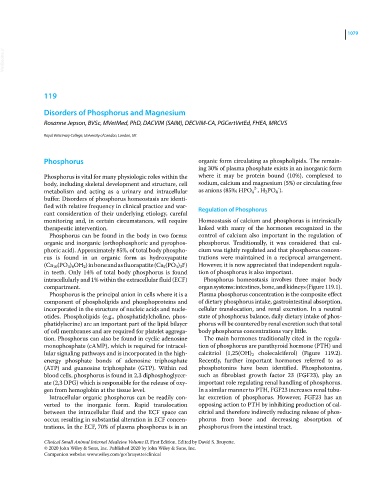Page 1141 - Clinical Small Animal Internal Medicine
P. 1141
1079
VetBooks.ir
119
Disorders of Phosphorus and Magnesium
Rosanne Jepson, BVSc, MVetMed, PhD, DACVIM (SAIM), DECVIM-CA, PGCertVetEd, FHEA, MRCVS
Royal Veterinary College, University of London, London, UK
Phosphorus organic form circulating as phospholipids. The remain
ing 30% of plasma phosphate exists in an inorganic form
Phosphorus is vital for many physiologic roles within the where it may be protein bound (10%), complexed to
body, including skeletal development and structure, cell sodium, calcium and magnesium (5%) or circulating free
2‐
‐
metabolism and acting as a urinary and intracellular as anions (85%; HPO 4 , H 2 PO 4 ).
buffer. Disorders of phosphorus homeostasis are identi
fied with relative frequency in clinical practice and war Regulation of Phosphorus
rant consideration of their underlying etiology, careful
monitoring and, in certain circumstances, will require Homeostasis of calcium and phosphorus is intrinsically
therapeutic intervention. linked with many of the hormones recognized in the
Phosphorus can be found in the body in two forms: control of calcium also important in the regulation of
organic and inorganic (orthophosphoric and pyrophos phosphorus. Traditionally, it was considered that cal
phoric acid). Approximately 85%, of total body phospho cium was tightly regulated and that phosphorus concen
rus is found in an organic form as hydroxyapatite trations were maintained in a reciprocal arrangement.
(Ca 10 (PO 4 ) 6 OH 2 ) in bone and as fluorapatite (Ca 5 (PO 4 ) 3 F) However, it is now appreciated that independent regula
in teeth. Only 14% of total body phosphorus is found tion of phosphorus is also important.
intracellularly and 1% within the extracellular fluid (ECF) Phosphorus homeostasis involves three major body
compartment. organ systems: intestines, bone, and kidneys (Figure 119.1).
Phosphorus is the principal anion in cells where it is a Plasma phosphorus concentration is the composite effect
component of phospholipids and phosphoproteins and of dietary phosphorus intake, gastrointestinal absorption,
incorporated in the structure of nucleic acids and nucle cellular translocation, and renal excretion. In a neutral
otides. Phospholipids (e.g., phosphatidylcholine, phos state of phosphorus balance, daily dietary intake of phos
phatidylserine) are an important part of the lipid bilayer phorus will be countered by renal excretion such that total
of cell membranes and are required for platelet aggrega body phosphorus concentrations vary little.
tion. Phosphorus can also be found in cyclic adenosine The main hormones traditionally cited in the regula
monophosphate (cAMP), which is required for intracel tion of phosphorus are parathyroid hormone (PTH) and
lular signaling pathways and is incorporated in the high‐ calcitriol (1,25(OH) 2 cholecalciferol) (Figure 119.2).
energy phosphate bonds of adenosine triphosphate Recently, further important hormones referred to as
(ATP) and guanosine triphosphate (GTP). Within red phosphotonins have been identified. Phosphotonins,
blood cells, phosphorus is found in 2,3 diphosphoglycer such as fibroblast growth factor 23 (FGF23), play an
ate (2,3 DPG) which is responsible for the release of oxy important role regulating renal handling of phosphorus.
gen from hemoglobin at the tissue level. In a similar manner to PTH, FGF23 increases renal tubu
Intracellular organic phosphorus can be readily con lar excretion of phosphorus. However, FGF23 has an
verted to the inorganic form. Rapid translocation opposing action to PTH by inhibiting production of cal
between the intracellular fluid and the ECF space can citriol and therefore indirectly reducing release of phos
occur, resulting in substantial alteration in ECF concen phorus from bone and decreasing absorption of
trations. In the ECF, 70% of plasma phosphorus is in an phosphorus from the intestinal tract.
Clinical Small Animal Internal Medicine Volume II, First Edition. Edited by David S. Bruyette.
© 2020 John Wiley & Sons, Inc. Published 2020 by John Wiley & Sons, Inc.
Companion website: www.wiley.com/go/bruyette/clinical

